Click on images to enlarge

infestation (Photo: Trevor James)

infestation (Photo: Forest and Kim Starr, USGS)
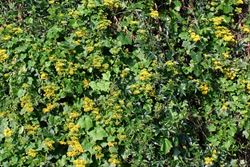
climbing habit (Photo: Trevor James)
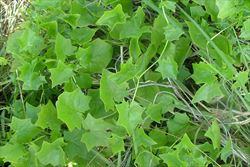
scrambling habit (Photo: Sheldon Navie)
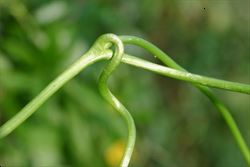
close-up of stem (Photo: Trevor James)

leaf with pointed lobes (Photo: Sheldon Navie)
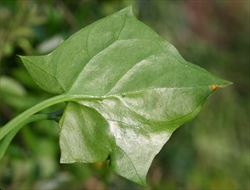
leaf underside (Photo: Trevor James)
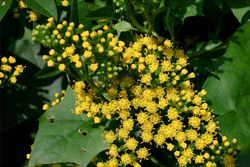
flower clusters (Photo: Trevor James)
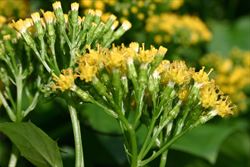
flower-heads (Photo: Trevor James)

close-up of flower-heads (Photo: Trevor James)
Scientific Name
Delairea odorata Lem.
Synonyms
Senecio mikanoides Otto ex Walp.Senecio scandens Buch.-Ham. ex D. Don
Family
Asteraceae (Queensland, New South Wales, the ACT, Victoria, Tasmania, Western Australia and the Northern Territory)Compositae (South Australia)
Common Names
African ivy, Cape ivy, climbing groundsel, German ivy, Italian ivy, ivy groundsel, mile-a-minute, parlor ivy
Origin
This species is native to southern Africa (i.e. Lesotho and Cape Province and Natal in South Africa).
Cultivation
Was commonly cultivated as a garden ornamental in temperate regions, and may often still be seen growing in gardens.
Naturalised Distribution
This species is widely naturalised in Australia, and is mostly found in the coastal regions of southern Australia. It is most common in eastern New South Wales, southern Victoria and south-eastern South Australia. Also naturalised in Tasmania, south-western Western Australia and on Lord Howe Island. Naturalised overseas in Hawaii, New Zealand and the USA.
Habitat
This species prefers to grow in wetter temperate regions, but will also occasionally be found in cooler sub-tropical environments. It invades waterways, moist gullies, closed forests and margins, open woodlands, roadsides, waste areas and coastal environs. Also commonly found in gardens and along fences.
Habit
A long-lived (i.e. perennial) climbing vine or dense creeping groundcover with stems usually growing to 5 m long, but occasionally reaching up to 10 m in length.
Distinguishing Features
- a climbing vine or creeping groundcover with slightly fleshy stems and leaves.
- its glossy leaves (3-10 cm long and 3-8 cm wide) have 3-10 small lobes that give them an ivy-like appearance.
- its small yellow flower-heads (2-7 mm across) do not have any obvious 'petals' and are borne in dense clusters.
- its tiny reddish-brown seeds (about 2 mm long) are topped with a ring of silky white hairs (5-6 mm long).
- its leaves give off a distinctive odour when crushed and this odour is also present during flowering.
Stems and Leaves
The stems are often purplish when young and rather weak. They soon become green and somewhat succulent in nature, and then eventually turn creamy-brown in colour and become slightly woody as they mature. These stems are rounded, usually less then 10 mm thick, and hairless (i.e. glabrous).
The leaves (3-10 cm long and 3-8 cm wide) are alternately arranged along the stems and have 3-10 small lobes or deeply toothed margins (i.e. they have an ivy-like shape). They are glossy in appearance, hairless (i.e. glabrous), somewhat fleshy (i.e. semi-succulent), and borne on stalks (i.e. petioles) 1.5-7 cm long. The upper leaf surfaces are light green in colour, or sometimes slightly purple-tinged, while the undersides of the leaves have a silvery appearance.
Flowers and Fruit
The small yellow flower-heads (i.e. capitula) have no 'petals' (i.e. ray florets) and are made up of several (10-12) tiny tubular florets surrounded by a row (i.e. involucre) of 8-10 small green bracts (3-5 mm long). These flower-heads (2-7 mm across and 2-5 mm long) are borne in dense clusters in the leaf forks or at the tips of the branches (i.e. in axillary or terminal corymbs), each cluster usually containing about 15-50 flower-heads. Flowering occurs mostly during winter and early spring.
The 'seeds' (i.e. achenes) are about 2 mm long and are reddish-brown in colour when mature. They are topped with a ring (i.e. pappus) of silky white hairs (5-6 mm long).
Reproduction and Dispersal
This species reproduces by seed and also vegetatively via stem fragments. The seeds and stem fragments are spread in contaminated soil and dumped garden waste, while the seeds are also dispersed by wind, water and animals.
Environmental Impact
Cape ivy (Delairea odorata) is regarded as a significant environmental weed in Victoria and South Australia, and as an environmental weed in New South Wales, Tasmania and Western Australia. It was recently listed as a priority environmental weed in three Natural Resource Management regions and is particularly invasive in the high rainfall areas of south-eastern Australia.
This species forms a dense smothering layer over trees, shrubs and/or the ground layer of vegetation that prevents the growth and regeneration of native species. In Victoria, Cape ivy (Delairea odorata) is seen as a very serious threat to a number of vegetation types ranging from dry coastal vegetation to riparian communities and sclerophyll forests.
It is also invasive in Hawaii, where it is a weed of dry forests, moist forests and coastal areas that grows rapidly, smothers native vegetation, and adversely affects the regeneration of native species.
Other Impacts
This species is also considered to be toxic to livestock and humans.
Legislation
This species is declared under legislation in the following states and territories:
- New South Wales: Class 4 - a locally controlled weed. The growth and spread of this species must be controlled according to the measures specified in a management plan published by the local control authority and the plant may not be sold, propagated or knowingly distributed (in the Hornsby, Hunters Hill, Ku-ring-gai, Lane Cove, Manly, Mosman, North Sydney, Parramatta, Ryde, Warringah and Willoughby local authority areas).
- Western Australia: Unassessed - this species is declared in other states or territories and is prohibited until assessed via a weed risk assessment (throughout the entire state).
Management
For information on the management of this species see the following resources:
- the Victorian Department of Primary Industries Coastal Note on Cape ivy, which is available online at http://www.dpi.vic.gov.au.
Similar Species
Cape ivy (Delairea odorata) is very similar to climbing groundsel (Senecio angulatus), canary creeper (Senecio tamoides) and Natal ivy (Senecio macroglossus). These species can be distinguished by the following differences:
- Cape ivy (Delairea odorata) has small bright yellow flower-heads (i.e. capitula) with no obvious 'petals' (i.e. ray florets).
- climbing groundsel (Senecio angulatus) has moderately large bright yellow flower-heads (i.e. capitula) with several 'petals' (i.e. ray florets) 6-9 mm long.
- canary creeper (Senecio tamoides) has moderately large bright yellow flower-heads (i.e. capitula) with several 'petals' (i.e. ray florets) about 10 mm long.
- Natal ivy (Senecio macroglossus) has relatively large pale yellow flower-heads (i.e. capitula) with several prominent 'petals' (i.e. ray florets) more than 2 cm long.
Its leaves are also similar in shape to those of English ivy (Hedera helix), but this species has inconspicuous greenish coloured flowers with five small petals and its stems and leaves are not fleshy (i.e. they are non-succulent).

